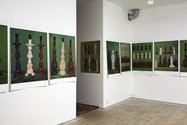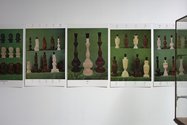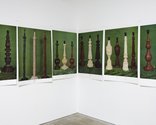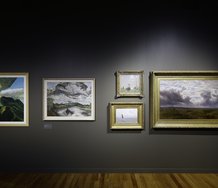Peter Ireland – 12 June, 2017
For the images in the exhibition Rizos has selected twenty pages from the original brochure and has blown them up as digital prints to 1120 mm x 740 mm, the Ben-Day dots becoming the size of small sunflowers and the green backgrounds revved up to a cruel emerald. The concept isn't pure and the effect ain't pretty. These relentless images pose a challenge - an expectation our thinking might change gear from the purist project of Modernism to the messy particulars of what has followed it.
Discussions around the nature of kitsch seem hot right now - Andrew Paul Wood on EyeContact on 26th May (1) and Grayson Perry in the Guardian on the 27th (2) are two pertinent examples - and now Lucien Rizos’ new show continues the conversation. The notion of kitsch was the bastard child of Modernism in much the same way as Hell was the dark offspring of the notion of a Heaven.
Given Modernism’s high-minded purism and conceptual values, anything its polar opposite required a dismissive label, and the label was ‘kitsch’. Clement Greenberg, that high-priest of Modernism, defined it as “art after the soul has departed” but he was only partly right. Few makers and defenders of kitsch ever really aspired to high ‘art’, so there was nothing much for any soul to depart from. (And whatever soul late abstraction may have possessed seems a pretty dubious quality to saddle it with today.) That kitsch wasn’t art was one of its glories, a one-fingered salute the mandarins missed entirely, a sense of humour being among the impurities Modernism despised, and the very element in Pop Art provoking Modernism’s initial refusal to take it seriously.
The advent of Postmodernism and its own offspring have effectively made the term kitsch redundant. Its hearty manifestations are simply covered by the term “popular culture”, which comes gluten- and guilt-free.
But, as Grayson Perry points out, the Modernist stance has cast a long shadow. Look at the recent trophy private collections in this country, for example: any number of McCahons and Walters but not many Judy Darraghs. Those kewpie dolls, plastic flowers and flickering fake candles are still clearly just a step too far. Rizos’ show comes with a modest but comprehensive catalogue including a provocatively thoughtful essay by Damian Skinner which partly addresses our relationship with kitsch within the context of the historical circumstances surrounding the objects Rizos pictures. Most art writers would find this an almost insurmountable challenge - the opportunity for ridicule would be much more fun - but Skinner’s wide-ranging scholarship and record of rescuing the ‘lesser arts’ allows him to speculate more generously and shed liberating light on the matter.
Photographer and film-maker of forty years, Lucien Rizos is likely to be an artist largely unknown to interested Aucklanders. Not only is he a committed Wellingtonian, he’s seldom sought the limelight in the public and even private gallery spheres. But he’s something of a photographers’ photographer, and while lacking much of a national profile personally, his work is known and respected widely within the image-making sector.
The inside story of this show goes back to the classically-infected cultures of Greece and Romania, embodied in the photographer’s uncle, John Fotiadis, who emigrated to Wellington in 1951. Six years later he established the business Marble Art Ltd in Miramar, based on a belief there was a European market for a range of wares - from chess-sets to lampstands - featuring motifs drawn from many cultures: classical European, Chinese, Indian and Maori. These motifs were more notional than precise, and the means of their reproduction only blurred the detail; the wares made from a composite material which, in a triumph of hope, emulated ivory, alabaster, wood and jade. It was the late 1950s: it helps to have been there.
The show’s catalogue is the photographer’s reconstruction of a 1970s’ brochure illustrating its products by Marble Art Ltd. In a twist of fate - but perhaps not - the original booklet was printed in Brancusi’s hometown of Tirgu-Jiu (3), hence (one supposes) the inclusion on the front cover an image of the sculptor’s famous Endless Column there. In a rather heady way this sort of free-association continues in Rizos’ project generally: initially random-seeming elements finally join up, the left-fields of their origins segueing into sense. This aspect of connection finds form in the catalogue’s inclusion of photographs from their albums of the displaced Romanian family, the portraits and domestic interiors hinting at the aesthetic on which the business was founded, and, too, the confidence that gave it strength and purpose. The publication also includes reproductions of documents charting the firm’s progress and newspaper articles proclaiming the firm’s success. These amount to reassurances that Marble Art Ltd was making a commercial fist of it and earning respect in a new land, far from home.
For the images in the exhibition Rizos has selected twenty pages from the original brochure and has blown them up as digital prints to 1120 mm x 740 mm, the Ben-Day dots becoming the size of small sunflowers and the green backgrounds revved up to a cruel emerald. The concept isn’t pure and the effect ain’t pretty. These relentless images pose a challenge - an expectation our thinking might change gear from the purist project of Modernism to the messy particulars of what has followed it, where rarified concepts get grounded in human experience, where the strictly pure might succumb to the endearing qualities of the familiar.
‘Lost in translation’ could be the motto for any colonial culture. The (measurable!) standards embedded in classical art and architecture end up in a place like New Zealand applied to cemetery statuary, Masonic lodges and provincial banks, memory being the yardstick rather than actual measurements. Among photographers no one has tracked this wonky history more assiduously than Laurence Aberhart. Our foundation rests on concrete and even wood trying to look like stone. Rizos’ affectionate re-presentation of John Fotiadis’s wares, their composite souls fatally attempting to express alabaster and jade, is a further step along this path of understanding, acceptance and yes, even love. As Skinner observes in his essay: “In this complicated and subtle interweaving of the lives of the Fotiadis family with the commercial trajectory of their company Marble Art Ltd., the lived reality of cultural discourse and the way people engage with objects becomes visible. I’m left with the feeling that my preconceived theoretical models and cultural judgements are too blunt to cope with the multiplicity of how things and people interact.”
Completed in 1938 as a war memorial, Brancusi’s Endless Column barely escaped demolition by Romania’s communist government in 1950. After the fall of the regime in 1989 the sculpture was found to be in a perilous state, but owing to the harnessing of national and international funding it was restored between 1998 and 2000. The endless column of art history is capable of restorations too, and the story of John Fotiadis’ faith and that of his faithful nephew begin to be restored by this timely and stimulating presentation.
Peter Ireland
(1) Sarah Contos and Linde Ivimey, EyeContact, 26 May 2017
(2) I am nostalgic for a time when art galleries were empty, Guardian, 27 May 2017
(3) Also spelt Targu-Jiu.






 Two Rooms presents a program of residencies and projects
Two Rooms presents a program of residencies and projects Advertising in this column
Advertising in this column



This Discussion has 0 comments.
Comment
Participate
Register to Participate.
Sign in
Sign in to an existing account.